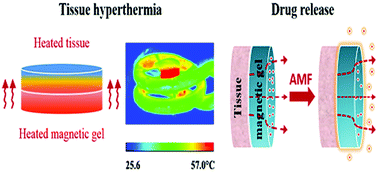Magnetic double-network hydrogels for tissue hyperthermia and drug release†
Abstract
Magnetic-field driven soft materials have found extensive applications in fields such as soft robotics, shape morphing and biomedicine. Compared to magnetoactive elastomers (MAEs), magnetic hydrogels have shown significant advantages for in vivo applications, because of their better biocompatibility, as well as their soft and wet nature. However, the poor mechanical properties and ion sensitivity of conventional magnetic hydrogels will severely limit their applications especially under physiological conditions. Double network hydrogels are tough and stable, but do not respond to environmental stimuli. Here magnetic double network (M-DN) hydrogels have been developed with outstanding mechanical performances and ion-resistant stability. M-DN hydrogels show a high modulus of ∼0.4 MPa and a high toughness of ∼1500 J m−2. The volume, magnetic and mechanical properties of M-DN hydrogels show negligible deterioration in ionic solutions. M-DN hydrogels exhibit magnetic responsiveness and have been used for tissue hyperthermia and drug release by magnetic induction heating. The induction heating behavior of M-DN hydrogels can be tuned to meet the clinical requirements, by changing the magnetic field strength or the composition of magnetic hydrogels. M-DN hydrogels may be inspiring to the development of responsive DN hydrogels and expand their more potential applications in load-bearing biomedical engineering.



 Please wait while we load your content...
Please wait while we load your content...